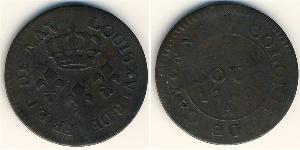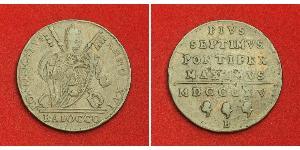(sold for $23.0)
1818, Venezuela, Caracas. Colonial Copper 1/8 Real Coin. VF+
Mint Year: 1818
Reference: KM-C#2.
Mint Place: Caracas (Venezuela)
Denomination: 1/8 Real (Royalist coinage)
Condtion: Minor weakness of strike, otherwise VF+ for issue!
Material: Copper
Diameter: 21mm
Weight: 2.01gm
Obverse: Crown above stylized royal arms (cross? inside circle and rampart lion) within stylized wreath. Date (1818) below.
Legend: ANO DE 1818 CARACAS
Reverse: Decorative arabesque knot above value (1/4), flanked by sprays.
In the early 19th century, while most of South America was swept by wars of independence, Peru remained a royalist stronghold. As the elite hesitated between emancipation and loyalty to the Spanish Monarchy, independence was achieved only after the military campaigns of José de San Martín and Simón Bolívar. During the early years of the Republic, endemic struggles for power between military leaders caused political instability.National identity was forged during this period, as Bolivarian projects for a Latin American Confederation foundered and a union with Bolivia proved ephemeral. Between the 1840s and 1860s, Peru enjoyed a period of stability under the presidency of Ramón Castilla through increased state revenues from guano exports. However, by the 1870s, these resources had been squandered, the country was heavily indebted, and political in-fighting was again on the rise.
Ferdinand VII (October 14, 1784 - September 29, 1833) was King of Spain from 1813 to 1833.
The eldest son of Charles IV, king of Spain, and of his wife Maria Louisa of Parma, he was born in the vast palace of El Escorial near Madrid.
When his father's abdication was extorted by a popular riot at Aranjuez in March 1808, he ascended the throne but turned again to Napoleon, in the hope that the emperor would support him. He was in his turn forced to make an abdication and imprisoned in France for almost seven years at the Chateau of Valencia in the town of Valencia.
In March 1814 the Allies returned him to Madrid. The Spanish people, blaming the liberal, enlightened policies of the Francophiles (afrancesados) for incurring the Napoleonic occupation and the Peninsular War, at first welcomed Fernando. Ferdinand soon found that while Spain was fighting for independence in his name and while in his name juntas had governed in Spanish America, a new world had been born of foreign invasion and domestic revolution. Spain was no longer an absolute monarchy under the liberal Constitution of 1812. Ferdinand, in being restored to the throne, guaranteed the liberals that he would govern on the basis of the existing constitution, but, encouraged by conservatives backed by the Church hierarchy, he rejected the constitution within weeks (May 4) and arrested the liberal leaders (May 10), justifying his actions as rejecting a constitution made by the Cortes in his absence and without his consent. Thus he had come back to assert the Bourbon doctrine that the sovereign authority resided in his person only.
After he succeeded to the throne in 1788 his one serious occupation was hunting. Affairs were left to be directed by his wife and her lover Manuel de Godoy. Although Godoy essentially took over his wife and his office, the king was favourable towards him for all his life. When terrified by the French Revolution he turned to the Inquisition to help him against the party which would have carried the reforming policy of Charles III much further. But he never took more than a passive part in the direction of his own government. He simply obeyed the impulse given him by the queen and Godoy. In 1803, after smallpox had affected his daughter Maria Luisa, the king commissioned his doctor Francisco Javier de Balmis to bring the vaccine to the Spanish colonies on state expenses.
He had a profound belief in his divine right and the sanctity of his person. He thought it very important to seem a very powerful monarch, although his kingdom was treated as a mere dependency by France and his throne was dominated by the queen and her lover. Spain allied with France and supported the Continental Blockade, but withdrew after the Battle of Trafalgar. When Napoleon won from Prussia in 1807, Godoy returned to the French side, but France no longer considered Spain a worthy ally. But even the alliance with France, as it was, made Godoy's rule unpopular and fueled the partido fernandista, the supporters of Ferdinand, who favored a close relationship with Great Britain.

|
Posted by:
anonymous 2016-11-28 |
2 Krone Norway Silver Haakon VII of Norway (1872 - 1957)
group has 18 coins / 16 prices
⇑
791 coins were uploaded from 2024-04-17 to 2024-04-24
One of them is:























